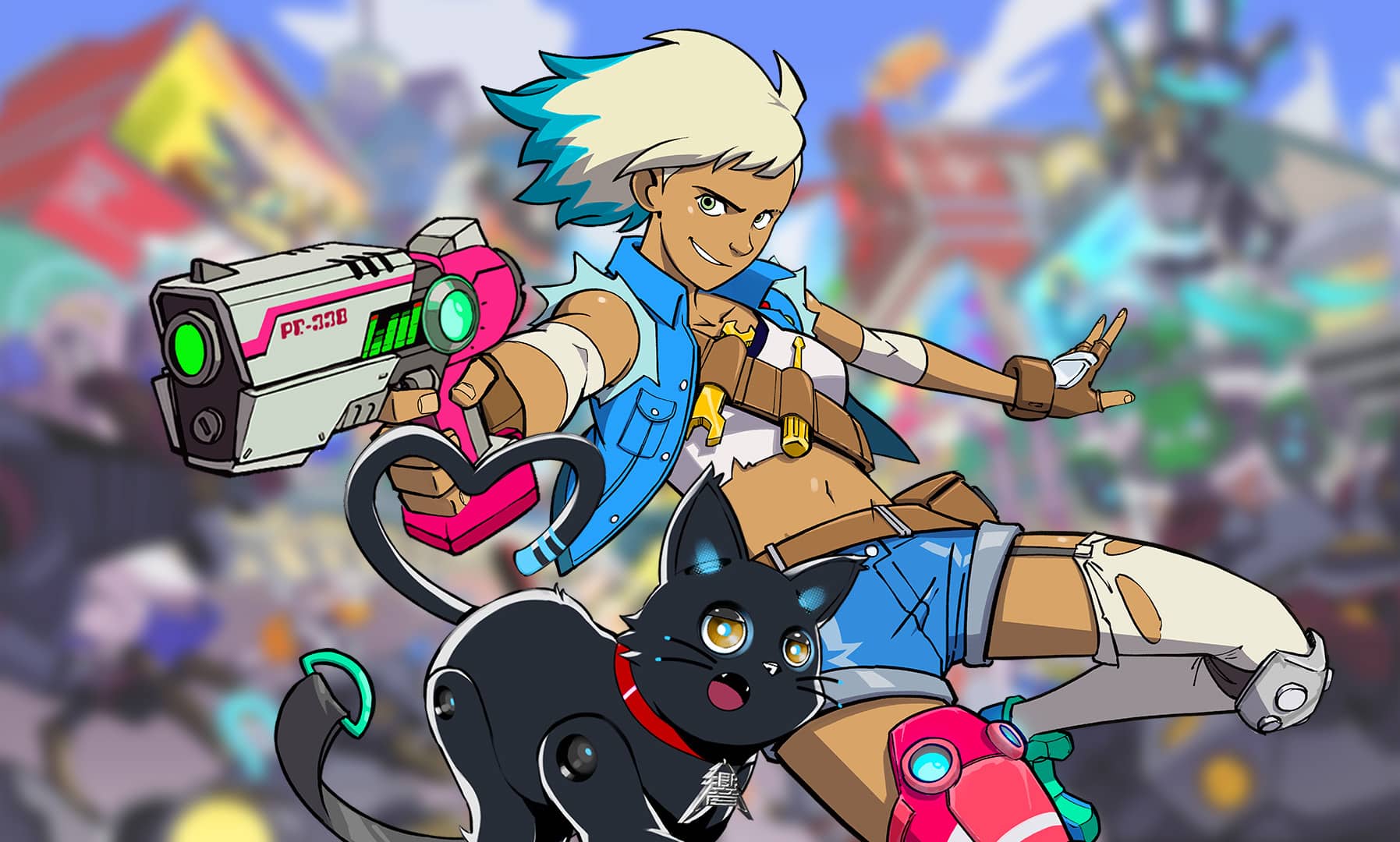Hi-Fi Rush was the big surprise to come out of the Xbox and Bethesda Developer Direct, a game both announced and released in the same breath – and widely accessible too, thanks to Xbox Game Pass. It was a perfect storm that helped Hi-Fi Rush dominate chatter on social media and games publications, with a sentiment that was virtually unanimous – it’s wonderful, and you need to play it.
But even though the ‘shadow drop’ of Hi-Fi Rush went as well as it possibly could have, thanks in no small part to the resources of a publisher like Bethesda, game director John Johanas told GamesHub: ‘I personally would not recommend it. It’s very stressful.’
Read: Hi-Fi Rush, the surprise Xbox exclusive game, is pure delight
Johanas miraculously found himself joining Tango Gameworks, headed up by Shinji Mikami (Resident Evil, God Hand, Vanquish) during its formation, after coming to Japan to teach English with the country’s JET programme, as well as taking on some small translation projects.

With no real game development experience, he committed himself to learning everything about it, then eventually found himself working on DLC content for The Evil Within. ‘I really took that as a chance to be like – I don’t want to make my coworkers feel bad – but I want my level to be the best level.’ He did such a good job, he ended up directing The Evil Within 2.
Even though Johanas says he came into Tango with no strong skillset, he puts his journey down to being able to listen and communicate well with people – perhaps a result of his strengths in translation. ‘It’s really a lot about communication, talking through your ideas, and learning how to present them in a way that enables people to readily accept them, or understand what you’re trying to do. And that’s a skill that’s not quickly learned.’
Hi-Fi Rush was something that had been kicking around in his head for a little while, with music culture and the films of Edgar Wright being a big part of his life – much like a whole generation that came of age during the late 1990s and early 2000s.
Plenty of people who played the game remarked on Hi-Fi Rush’s throwback feeling – it feels like a game that should have come out during the Dreamcast or GameCube era. ‘That was 1000% a conscious decision,’ Johanas told us. ‘It was literally in our pitch document.’
That period of games was ‘a time where games were just fun, and also experimenting with visuals, but they were also super, super memorable,’ said Johanas. ‘So we just wanted something that felt like it could exist now at a very high level, and we can go back to it and it’ll still look kind of good, it’ll still play good.’
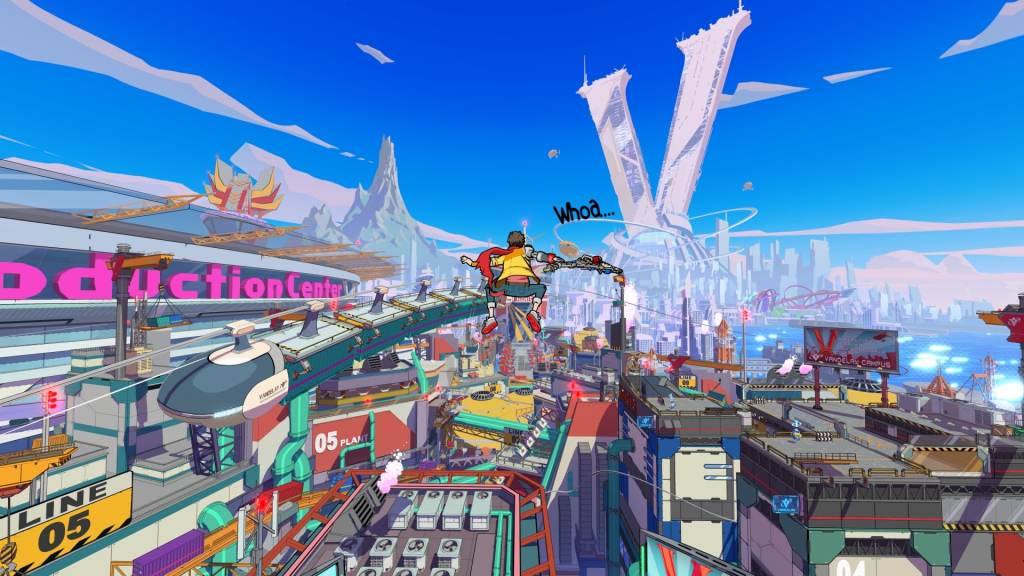
The obvious influences from the era are titles like Jet Set Radio, but it also draws on games like Marvel Vs. Capcom, Viewtiful Joe, Okami, and other titles from Capcom’s legendary but now-defunct Clover Studio, many of which Tango founder Shinji Mikami worked on. (Coincidentally, Resident Evil 4, another Mikami title from the era, is being brought back for 2023.)
The Matt Groening show Futurama also played a big part in Johanas’ imagining of the world. Both share a futuristic, comedic universe full of metatextual elements and goofball characters. As a result, Hi-Fi Rush is filled with plenty of neat references, including setpiece and script elements that act as tributes to things like Edgar Wright films, Jo Jo’s Bizarre Adventure, Twin Peaks, and Johanas’ favourite: the SquareSoft RPG classic, Xenogears.
‘So there’s a part later in the game where we use a reference from one of my favourite games, Xenogears… where they just have the character sitting in a chair talking about what they did.’
‘And we actually contacted Square Enix – and I want to give a shout out to them because they gave us approval – they’re like, ‘Yeah, okay. That’s weird. But okay.’ A lot of us were fans of that, so we set it up shot-for-shot.’
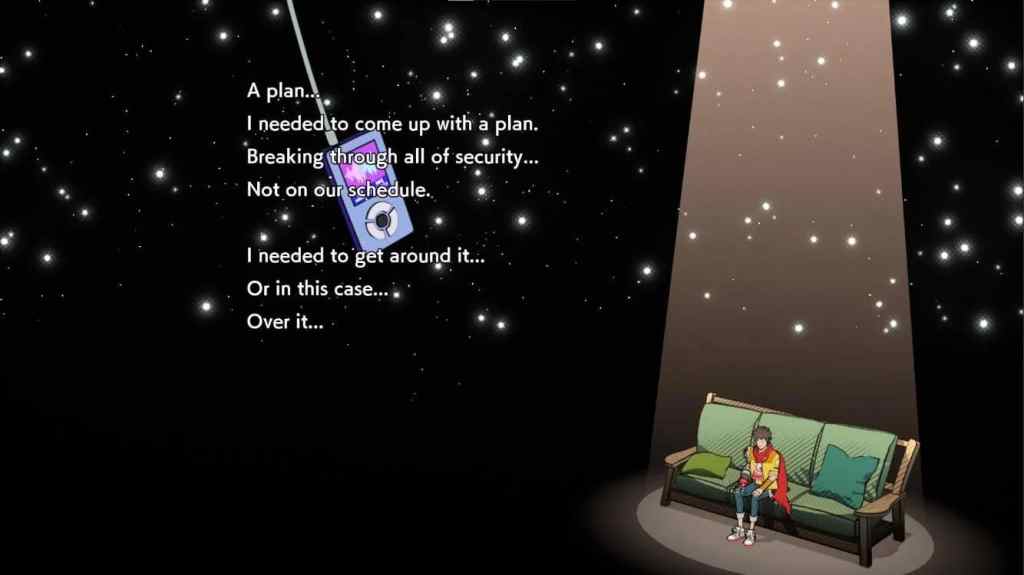
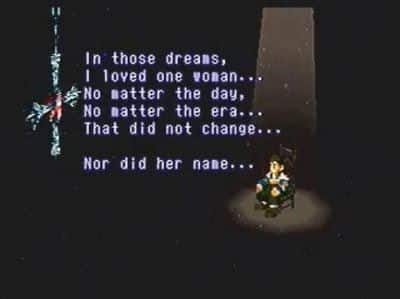
‘People were just like, ‘Why are we doing this?’ And I’m like, ‘Oh, God, please just let me!’ … there were some other people who really loved that game and loved that reference, so they took the extra effort to make sure it was perfect.’
More insight on the development on Hi-Fi Rush, including its inception, surprise release, and the myriad of references and influences can be found in our full interview transcript below.
Hi-Fi Rush is available now on Xbox and PC, and is included as part of Xbox Game Pass subscriptions.
Hi-Fi Rush interview with John Johanas, Game Director
Note: This interview has been edited for clarity and brevity.
GamesHub: There’s a shared sentiment going around, about how Hi-Fi Rush feels like a game from the early 2000s. It reminds people of Dreamcast and GameCube games like Jet Set Radio and Viewtiful Joe. It features bands from the era like Zwan, and has Edgar Wright film references … was all that a conscious decision from the get-go?
John Johanas, Director, Hi-Fi Rush: That was 1000% a conscious decision. It was literally in our pitch document. We used Edgar Wright as an example of that sort of kinetic action and comedy feel. We used the games that you described, like Jet Set Radio, Viewtiful Joe, Okami, and things like that as a genre of games or time period, like the Dreamcast era, Xbox era. A time when games were just fun, and also experimenting with visuals, but they were also super, super memorable. We still talk about them today as being super high quality, right?
The trend of going to very realistic graphics is just everywhere. It’s also very difficult to keep up with a trend, and in a couple of years, those styles get outdated. So we just wanted something that felt like it could exist now at a very high level, and we can go back to it and it’ll still look kind of good, it’ll still play good.
We made sure that it was fun first, gameplay first, and then these memorable visuals that could theoretically, hopefully, stand the test of time and be like one of those games that you just kind of remember.
So yeah, that was definitely right from the beginning, that was the goal we were aiming for. So, to see people react like that is just absolutely phenomenal to hear.
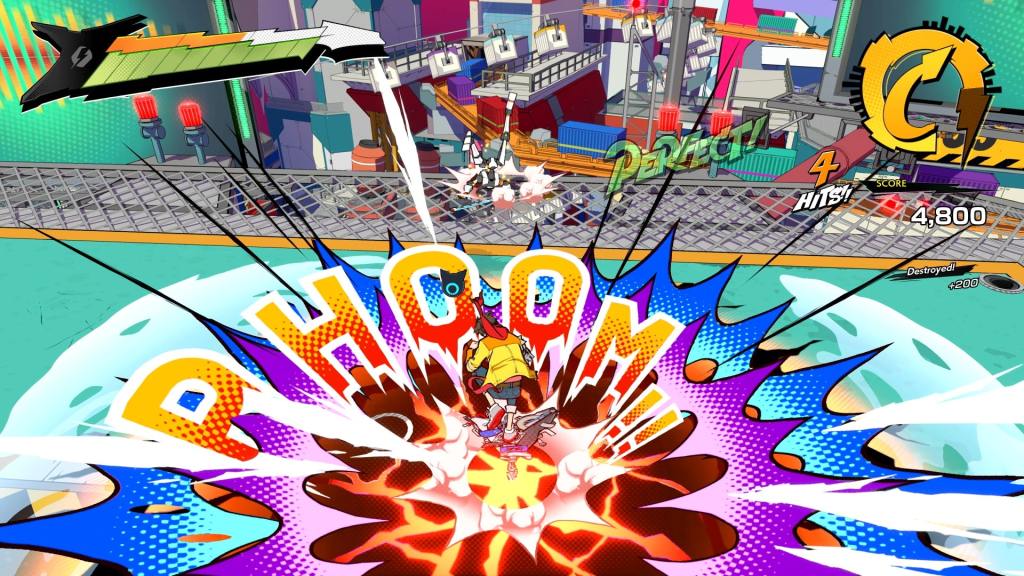
The technical engineering of Hi-Fi Rush feels so precise. Everything is obviously set to the beat, but the seamless transitions from gameplay to cutscene and back again without missing that beat… it’s so perfect. I’ve seen a lot of game developers especially just being blown away by that. Was that a painstaking process?
Getting to that level was extremely painstaking, but not in a very negative way… just in a kind of ‘figuring it all out’ way.
Right at the beginning, it was just myself and one programmer. And I started designing this system where all the animation would have to sort of interpolate to the rhythm, regardless of when it happens – because we have different BPM different speeds like that. And then the whole idea was that everything has to match up, and we don’t want to lose that rhythm at all. It’d be like the music cutting out, it just ruins the vibe.
So from an animation technical level, we had to rethink how we made all our animations … and we couldn’t have that sort of clunkiness in there because again, that would just take us out of the mood, and we didn’t want that to go away.
So yeah, the team spent an immense amount of effort on it, and probably hated me when I was being very picky, like, ‘This is an eighth note too late, I’m sorry, you have to do it again’.
But luckily, it all came together in the end. For a while, we were doing this without just a click track (with no musical track) and people were like, ‘is this going to work?’ But then when all the pieces come together with the animation, the music popping in, the visual effects come in, and everything’s synced… everyone’s like, ‘Okay. Now I get it. I see it.’
I wouldn’t recommend anyone just be like, ‘Oh, this seems super easy, let’s just give this a try’ – it was extremely difficult. Just assume everything took three times longer than it should have taken.
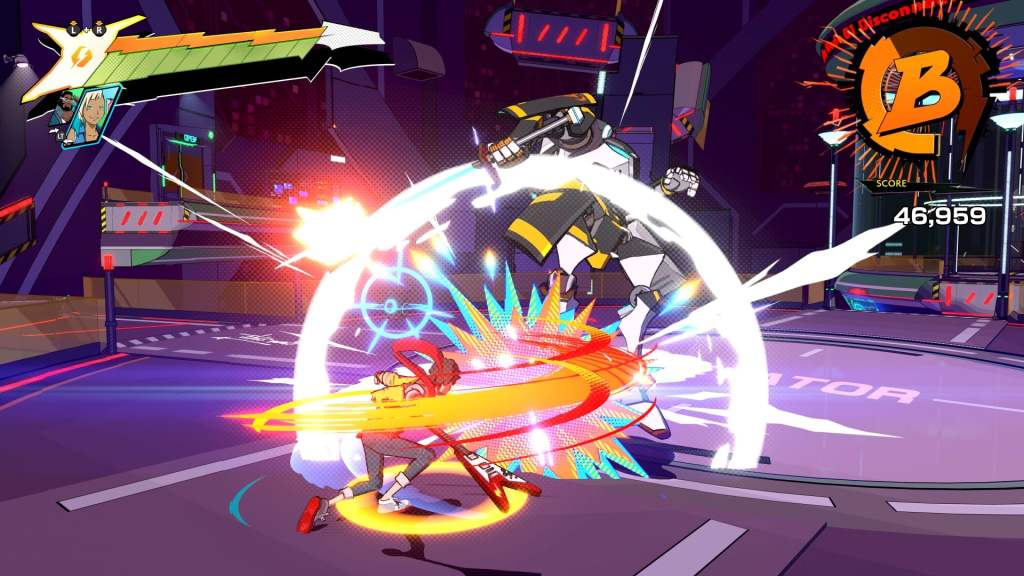
Was it tough to get people to trust you that it would all work out?
In the beginning, everyone was a little bit nervous, but I showed them [a vertical slice] to show it can be done. But then the problem was like ‘okay, now we have to do it for the whole game?’. And I’m like ‘yeah,’ and they’re like ‘oh my God!’
But again, everything was super calculated. I made sure that all the documents we did were very, very specific on things like when we’re going to cut, when things were going to happen… It was almost like a bar graph where we’re dividing the game stages into verses and choruses, which is totally different than anything we’ve ever done.
So it was almost like relearning how to make a video game. I want to say all our skills led up to this, but we kind of had to rethink everything we did when we made this.
So knowing how dramatically different and difficult this project was going to be, was it a hard sell internally?
Yes, it was. (Laughs)
When I pitched it, I didn’t pitch it internally to the higher-ups. I pitched it to my boss (Shinji Mikami) and our producer, and I was like, ‘Here’s something that is, the most un-Bethesda-like game that could possibly happen. So I don’t think this is going to get approved, but I want to pitch it.’
But I knew in the case of my boss, he hasn’t just worked on survival horror. And I know he has a wide range of experience working in action games, so he’s very open to new, interesting ideas. That’s why I thought I could at least take this first step into doing it.
And then we were able to prototype the idea, And we made this prototype that was essentially that core loop of fights that matched up to the beat – you hit a beat hit, the environment kind of moves to the rhythm, and it was all grey boxed.
We passed that off internally to Bethesda, a couple of people played it, and then they’re like, ‘Hey, you gotta check this out.’ And then they talked about it and shared it, and it kind of became like a weird underground, watercooler conversation starter in the office.
So then when we finally came to present it, they already knew about it. And then they’re like, ‘This is really weird, but everyone says it’s really fun, so let’s give it a try.’
This was a pre-Microsoft acquisition thing, so at that time, this was something that had never been done before. It was a huge risk for them to take, so I’m totally grateful for them approving this crazy idea, but everyone saw the potential in it as well. So I want to believe that they believed in it.
So you announced and released it on the same day – a shadow drop. Would you recommend it?
I personally would not recommend it, it’s very stressful (laughs).
Because you’re sitting on it for a long time without actually being able to see people see it. But all the credit for the shadow drop has to go to the marketing and PR team because that was their idea.
As developers, we think it’s really good, and we’re very proud of it. But we’ve always made horror games – What if people see it, and they react negatively to it? So we can see the positives and negatives of both sides.
Internally, we were very nervous. We didn’t know how it would be received, but we knew we had something special. So we hoped that it would come out, people would be able to play it instantly, and any theoretical misgivings or fears that it’s a poorly made game, or something that we’re not capable of doing, would be immediately dismissed because of the access they had.
So we think it went as great as it possibly could have been in that sense.
We talked a bit already about the comparisons to a bunch of other media, but are there any other reference points you used for the game that you haven’t seen mentioned as much?
There’s a ton of stuff – we were just looking at very, colourful throwback things from that era on the Dreamcast, PlayStation 2, Xbox, especially games that my bosses worked on.
Even fighting games like Marvel Vs. Capcom – we have you summoning your partners to do attacks and things like that, and it’s a team effort.
We also really just wanted these really fun characters that you wanted to play with, because we knew we were making a character action game, and people stay with those characters. But a good influence were comedy shows like Futurama, for example, as this inherent goofy world that has a ton of opportunity to play with these ridiculous scenarios as a sort of tonal piece as well. They also have a lot of characters, with lots of different arcs, and the main character is also not a superhero but kind of a goofball… so those were some good inspirations too.
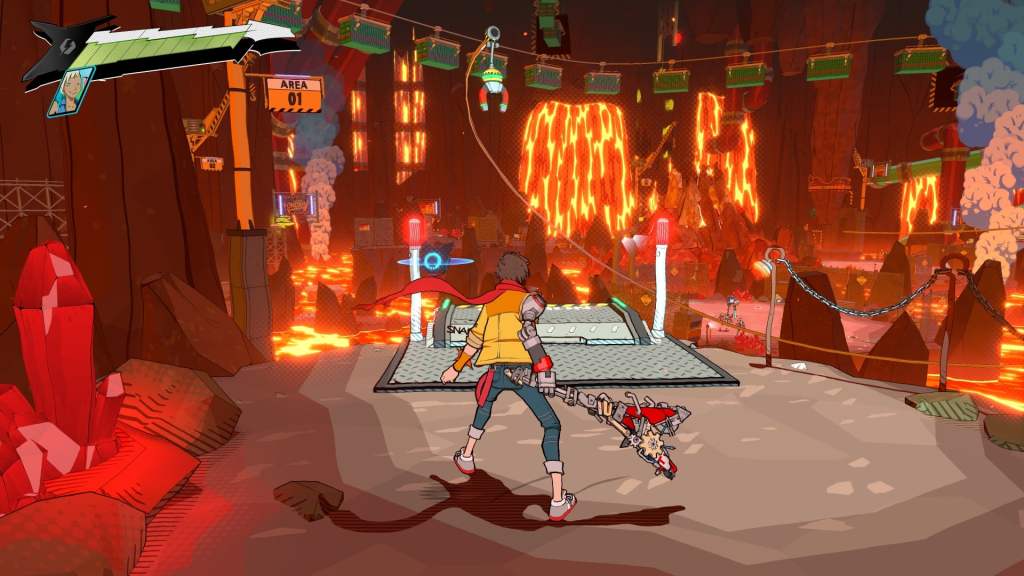
Being a bit of a comedy game there are a lot of metatextual elements and references, do you have a favourite nod?
A lot of those notes actually came from people within the team – some of them I didn’t even put in, they kind of worked themselves in!
But there was one that I was very adamant on doing, and I’m not ashamed to admit it, because we needed to cut the stage, and I didn’t want to cut it at first. But I’m like, ‘if we’re going to cut it, we’re going to cut it and we’re going to make sure people know we cut it.’
So there’s a part later in the game where we use a reference from one of my favourite games, Xenogears from Squaresoft – well, at that point Squaresoft, now Square Enix – where they just have the character sitting in a chair talking about what they did.


And we actually contacted Square Enix – and I want to give a shout out to them because they gave us approval – they’re like, ‘Yeah, okay. That’s weird. But okay.’
But a lot of us were fans of that, so we set it up shot-for-shot. There’s the whole sitting down thing, there’s like a mural in the background, instead of a rosary bead it’s a music player swinging from the earphone.
And again, people were just like, ‘Why are we doing this?’ And I’m like, ‘Oh, God, please just let me!’ So that was one of my favourite ones, but there were some other people who really loved that game and loved that reference, so they took the extra effort to make sure it was perfect.
Hi-Fi Rush is available now on Xbox and PC, and is included as part of Xbox Game Pass subscriptions.
